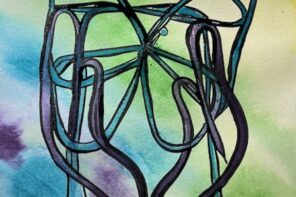Lynne Tillman, visiting Hurst Professor in Fiction at Washington University in St. Louis for Fall 2016, speaks with MFA candidate Joel Sherman about writing and visual art, Clint Eastwood and Gregory Peck, fiction and nonfiction, and her latest novel.
Lynne Tillman is the author of five novels, four collections of short stories, two collections of essays, and two nonfiction books. She is the recipient of a Guggenheim Fellowship and in 2014 was a finalist for the National Book Award, and she is currently a Professor at the University at Albany. A new collection of stories, THE COMPLETE MADAME REALISM AND OTHER STORIES, has just been published by Semiotext(e). A new novel, Men And Apparitions, is forthcoming in 2017.
Joel Sherman: I’m curious to know your thoughts about the relationship between reading and writing, especially when you’re in the middle of working on a project.
Lynne Tillman: I don’t think there’s any writing without reading—there shouldn’t be—but when I’m writing a novel and when I have time to concentrate I really want to stay in the voice of the character, and particularly with contemporary writers, that is, good ones, it’s too easy to be thrown off your own voice; I mean not my voice, the character’s voice, I don’t really think of myself as having a voice particularly. So when I’m writing like that I’m thinking about how am I going to figure out this part, or how am I going to write this sentence, and so I’m reading as a writer, to see how other people are doing it, and it’s a little less problematic reading something from longer ago, I would say.
JS: What about the relationship between writing and the visual arts, particularly with relation to the collection of stories This Is Not It, stories inspired by works of other contemporary artists.
LT: Artists deal with different problems from writers, but the way artists approach what they do opens up ways of thinking about writing, and I am very interested in why they make what they do, and, as a writer who is partial to narrative and my own way of doing it, I begin to think about what’s behind a work, what’s the motivation, how can I represent that in a story. It takes all different forms, sometimes it’s more direct than other times. I wrote a prose piece for Stephen Ellis, who’s in the book, he does abstract painting, but there are referential bits that you can make into objects if you want, and so I was thinking about, what is this painting articulating, and I tried to do that through its own elements, different colors, and I could never do it again. [laughs]
JS: It was inspired in the moment by that . . .
LT: The writing is the work, the inspiration is like one percent. The rest is figuring out how to make it into words, what to do with it. It’s like an idea, Einstein might have had the idea about relativity but he had to prove it. It’s the same thing, it’s not a slam dunk.
JS: It’s a lot of work after the flash.
LT: That’s right, a lot of, lot of work. That’s what I think non-writers, non-artists, non-scientists don’t understand, that the idea or the inspiration is not the work. There’s a big difference.
JS: From This Is Not It, you read “The Undiagnosed” at the reading, and afterward an audience member had maybe mistaken it for nonfiction, and later you were telling us that’s happened before, and I’m curious if there’s something about that piece that lends itself to being mistaken for nonfiction. Obviously, it includes a character named Clint Eastwood . . .
LT: I think that’s a big part of it. I wrote a piece, an earlier piece, called “Dead Talk,” and it was supposed to be the last day of Marilyn Monroe’s life, and I wrote it in third person and first person, descriptions of her day, and then first person as if her own diary, her thoughts. I remember going around, this was in 1990, going around England reading from it, reading it from a collection of stories, Absence Makes the Heart, and everywhere people thought it was me, and even though I’d said Marilyn Monroe, it didn’t seem to matter. I think it’s a mistaken idea that something is truth if it’s actual or that fiction is somehow disingenuous. A so-called true event, which is of course not truth, not necessarily true, is just an event, it can be rendered poorly, inaccurately or without interest. It’s very annoying to me, when fiction writers say about their own work, this is a true story. I say all fiction can be true if it’s well written.
So, a lot of people thought I had met Clint Eastwood and had that conversation, and I think there’s a desire when it is somebody like Clint Eastwood that we get a little closer to him, we do know him. I watched a documentary last night on my computer about Gregory Peck, and before he died he had a one-man show going around the country showing clips from his movies and talking about his life, and his daughter made a documentary—Barbara Kopple actually directed it—using some of that material and other material, and his desire was that people know that he was a genuine person. It’s a wonderful documentary.
JS: He’s one of those actors who, for me, he’s so ingrained as Atticus Finch.
LT: That’s right and he said that was his favorite role, and the person who was called Scout, the little girl, was in one of the audiences, and they remained friends, and she calls him Atticus, and he calls her Scout, still.
JS: [laughing] That’s funny. That might complicate his message a little bit.
So, assuming both fiction and nonfiction can be true, or can represent truth in a way, as somebody who’s written essays and fictional stories, I’m interested in the different sort of work you see a fictional story doing in the world compared to an essay.
LT: It’s a hard question. I’d say that when I write what I think of more or less as an essay, it gathers itself around an already existing object. When I write fiction, even though you might say there’s an object, I’m more interested in creating a subjective response, and often there is no object, I’m just inventing something to write about, although everything comes from somewhere. If I’m writing about the presidential election, I’ve just written a couple of essays for my column in Frieze Magazine that relate to the election and campaigning, but I didn’t invent Trump, otherwise you could shoot me. [laughs]
JS: I find it really impressive how you are able to tackle issues like that in fictional works as well. That’s something that not as many people are doing. From Someday This Will Be Funny, the Madame Realism story in that collection, “Madame Realism’s Conscience,” draws on the politics of that time period, and also on past politics—JFK’s a brief character—and you’re able to weave together essayistic elements—in that story jokes also play a central role—in a way that I found fascinating, to be able to do that in a fictional story and also create a narrative.
LT: So you have a character who is speaking about other characters. I was asked to write a piece for the Albany Museum, the University Museum was doing a show called The Presidents, and it was contemporary artists who were working representationally with portraits of presidents, or other ways, say, having to do with the Oval Office, or that kind of power. Madame Realism enabled me to approach this topic, in a fictional way. Using a fictional character, in that way, is a gateway to being able to fictionalize nonfiction, and to nonfictionalize fiction [laughs] or something like that. I think often the problem when writers aren’t effective doing that, it’s about being too heavy handed, and too didactic, and using it only to make a point, and in fiction if you do that it creates just one reading of something. I think one of the Madame Realism stories that was maybe too like that, too directed, was about Haim Steinbach’s work, it’s in This Is Not It, and it has to do with high and low, and the reason I thought about that was that Haim Steinbach’s work is about high and low, about putting a kind of ordinary object on a plinth or shelves as a form of sculpture, and he might have three objects on a shelf, and one of them may be just a silly rubber duck or something like that, I don’t think he’s ever done that, and it was this idea of mixing high and low, which was done very strongly by Warhol and pop artists. And Madame Realism goes into a bar and I wrote a kind of mock argument between her and John Hightower, and I’m still not sure if that’s what I should’ve done, but I always like having a character at a bar [laughs] because I like bars and what could happen there, so I think some of it worked.
JS: Another story I was interested in asking you about, which doesn’t use a sort of direct narrator as intermediary, is “Lunacies,” from Someday This Will Be Funny, which seems to me one that is also kind of playing on the boundary between . . .
LT: Fiction and nonfiction.
JS: Right.
LT: Yes, I wrote that for a book, a book and an art exhibition that Steven Hull developed which had to do with responding to the moon, and I began thinking about lunacy and the moon, and how what’s interesting to me was the idea of trying to be rational about the moon, at the same time that we look up at a glowing full moon, or a half moon, and can’t help sometimes but see it in an irrational way, and it does look like it has a face, [laughs] and it may never stop looking like it has a face. So that’s an interesting question for me about the human desire to have a subjective, irrational or imaginative response to something. While we know about the moon scientifically now, information you can’t challenge, but that we still want to. So that’s how I wrote that story, using different facts about the moon juxtaposed to stories of lunacy.
JS: I first encountered that in a class on microfiction, it was excerpted in Short, an anthology of flash fiction, and I was curious about, for someone who has written some very short stories and also many novels, your approach to scale in writing. I guess I’m curious when you start to work on a project, do you often or ever have an idea of the scale of what it’s going to become or is that something that grows out of the writing process?
LT: I think with novels I know I want to be writing a novel. When you write a novel you’re working with several ideas that are, at least to your way of thinking, large ideas that can’t be contained in one story; although Kafka’s “A Hunger Artist” is sometimes talked about as a novel and some short stories that I’ve read and some that I’ve written seem to me to be a whole world and not just a kind of episode or incident. So this most recent novel that I just finished, Men And Apparitions, I knew what I wanted to do, I knew it was a novel. I consider myself first and foremost a novelist, because that’s what I like to do best, to develop a longer argument, a longer work with big ideas, that I think are big, and figure out how to narrate them. So for instance with American Genius, A Comedy that came about when I started thinking about sensitivity, and how Americans are sensitive about everything and yet we invaded Iraq, so from sensitivity, how do you tell that story? Then I wanted to talk about America—at first I was just going to call it “American Skin” but that did not describe it, and really limited it, but skin is used as a trope throughout the novel. It is the biggest organ of the body, it contracts and expands, so the novel goes from small things, like talking about dry skin on a part of your body, to big things, like the US Constitution to art of the early Twentieth Century to inaugural addresses to Kafka. It talks about a lot of stuff, and I’m trying to expand and contract the novel, going from the little to the big, or from the individual to the group or the nation.
With Men And Apparitions, the novel I just finished, I do a lot of thinking about visual art and photography and culture in general. We’re living in a time, everybody has been saying this for at least 40 years, we’re living in a glut of images, which is almost so common as not to be said anymore, and the glut has gotten bigger and bigger and bigger, and I thought, well, how do you narrate that? How do you tell the story of a glut of images, living in a glut of images? I figured out a way but it took me years, and first I wrote a short story for something else, and I was interested in the character, this young guy who was an anthropologist, and I thought, I’m going to use him, and it got more and more complicated and conceptually, structurally, it was very hard to figure out how to do. There’s a lot of expository material, a lot of what you would call nonfiction, written from his point of view and in his voice. He’s an ethnographer and he’s also interested in the history of photography, and he’s thinking about what an image is. He’s done two books on family photographs, and inside mine I did a nonfiction, another book, which is supposed to be Zeke’s book, his name is Ezekiel, Zeke’s book of men. He’s 38, and he’s interested in the age group of about 25-45, men born under the sign of feminism, after the women’s movement, and I wanted to know, being friends with a lot of such guys, how do they think they’re different from their fathers. So I sent out an email questionnaire, to about 25-30 people, and I said it’s all going to be anonymous, and I’m going to be quoting. So they are quotes from people, and the book is called, the book within the book, is called Men In Quotes. That’s going to be the appendix, so you’re going to finish the novel, so to speak, and then there’s this other.
JS: And that’s his entire book?
LT: Yes.
JS: Wow, and that’s where the quotes would appear.
LT: That’s right.
JS: I’m assuming also you probably did research on ethnography and the history of photography.
LT: I sat in on a graduate course in the history of photography, I write about photography, and I’d also been reading stuff over the years, and also I was a graduate student in sociology, so I started studying cultural anthropology then and read more and became really interested in that. So I had some background, and then I added to it.
JS: That sounds really great.
LT: Keeping this thing up in the air was juggling more balls than I’ve ever juggled before. [laughs]




